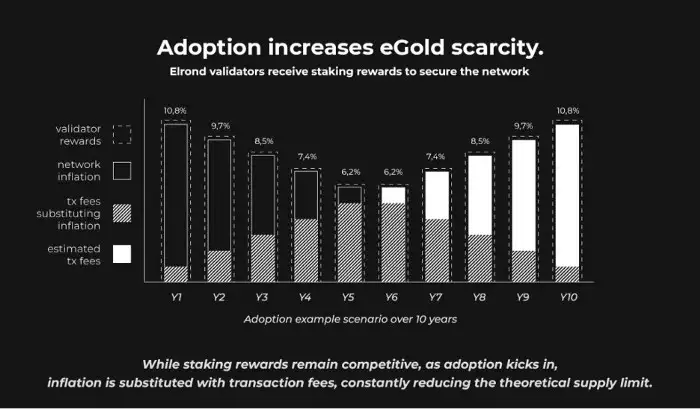Who are we?
For those who haven’t heard about AshSwap, we are the first stable-swap exchange built on the Elrond blockchain. We aim to take part in the DeFi development on Elrond and bring enhanced yield dynamics to blockchain users in general and Elrond users in specific.
More on us here. All articles on us can be found at
What is Elrond?

The DeFi summer in 2020 showed the world two things. The first thing is the power and the potential of decentralized applications (or Dapps) in a lot of fields such as Finance, Insurance, and Games. They can very well disrupt traditional products and make a huge impact on the life of run-of-the-mill people. The second is the limit of the existing smart contract blockchains and the opportunity for other new projects. During the following bull market, even though Ethereum is still undoubtedly the leader in this space, we have witnessed multiple smart contract blockchains, both layer-1 and layer-2, attracting developers and users, rallying up to their ATHs, and yielding a lot of X’s to their coin holders. Some of the most noticeable ones are Solana, Polygon, Cardano…
It is true that the network effects Ethereum has built having the advantage of being the first mover in this space have made them the second-largest blockchain/crypto projects based on market cap, only succumbing to the mighty Bitcoin. There is no doubt that Ethereum has good tech; the blockchain has been acknowledged as one of the most secure blockchains and become the security foundation of many layer-2 and fork projects. However, Ethereum has a serious problem in Scalability, like its founder, Vitalik Buterin, has stated in the Trilemma (Security, Scalability, and Decentralization) problem. Using Ethereum is so expensive; a simple ERC20 token transfer at the time of writing costs about $20, which most retail users find unaffordable. Ethereum is also a Proof-of-Work blockchain that is not very eco-friendly. Ethereum knows all of these problems and is trying to mitigate problems in their coming big update named Serenity, or Ethereum 2.0, but the promised release date is still quite far away, and there is still a lot of uncertainty.
From this stems a lot of projects that are recognized (or self-claimed) as “Ethereum Killer”. These projects depending on their tech and trade-off decisions have balanced the trilemma triangle so that their users can enjoy low transaction fees on secure decentralized blockchains, and they mostly use Proof-of-Stake consensus to make our planet greener. This is nothing short of great to users and Dapps developers alike, but it introduces a new problem. How do you choose which blockchain to build on? During our research, we discovered Elrond which appears to be a very promising one.
Why Elrond?
When considering a blockchain, we look at a couple of criteria such as Technology, Vision, Economics Model, and Community.
Technology
We at AshSwap really like the way Elrond re-imagined the blockchain and decided to code the blockchain from scratch instead of forking and incrementally improving any existing projects. This proves that the team is technically capable and has the ability to execute their visions. That is not just the spirit alone, the technology powering the Elrond blockchain is actually very advanced.
Adaptive State Sharding
Sharding is one of the hottest scaling solutions that are being adopted by blockchains like Ethereum 2.0, Near, and Zilliqa, just to name a few. If you want to dive deeper, take a look at their whitepaper, but here are the claims:
- Elrond has combined all three of the sharding methods: State Sharding, Transactions Sharding, and Network Sharding.
- The network is capable of scaling (almost) without theoretical limits.
- Transaction fees are cheap but the network is still secure.
Secure Proof-of-Stake
PoS is surely the trend as most modern blockchains follow this model. This allows the network to run smoothly on normal computers, making decentralization actually affordable. Elrond also adds extra security thoughts into their implementation with random nodes shuffling and random validator selection. This is one of the things that starting from scratch can bring you.
Vision
The next 1 billion users
Regardless of all the hypes and mania of the crypto market, the percentage of crypto holders, not to mention crypto holders, is less than 5% of the world population. To grow to its full potential, blockchain needs to become mainstream and reach a larger audience. Elrond seems to have thought about this and have a plan. This can be seen in their effort to create the Maiar Wallet app, which provides Elrond users with a beautiful interface and easy experience.
We have a similar vision of creating one of the most user-friendly decentralized exchanges with the purpose of serving users with little to no prior experience with blockchain. This, therefore, resonates with us the most.
Economics Model
Inflation vs Fees
The inflationary token reward model is worrisome for every project as they have to bear constant sell pressure and find new use cases for the tokens. But there is only so much you can come up with. Look at Uniswap, one of the largest projects in the market, the governance token UNI has been around for some time and the only use case it has is voting, though its DAO is not that well established. Ethereum, after being inflationary for quite some time, in the latest London update, has introduced some mechanism to burn some of the circulating ETH to make it more scarce.
Having recognized this problem, Elrond has already thought of a solution, which is to increase EGLD’s scarcity as the network’s adoption grows. You can check out Elrond Economic Paper to understand better.


30% Gas Commissions
Normally, the ones who can benefit from the transaction fees are the validators. This is fair, but Elrond introduces some very interesting rewards for Dapps developers. 30% transaction fee is eligible for the smart contract developers to claim. This can be the first time blockchain projects have actual “revenue” from their Dapps.
Blockchain is a long-term game, all the mechanisms that can make the ecosystem sustainable will be appreciated, especially when it is done right at the very beginning.
Community
Developers and users are the two forces that can make blockchain ecosystems thrive. It is like the story of the chicken and the egg. More developers making good products attract more users, and an ecosystem with more users is appealing to developers. Elrond really shines in this regard.
Elrond has the second most enthusiastic community in the whole blockchain space. The recent Maiar DEX and Holoride launches have shown that the community is very supportive, knowledgeable, and open-minded. This is an ideal target audience for any project, and we are no exception. We hope to bring the community the best product and user experience. Find us on our social channels.
Acknowledgments
Special thanks to Wesley Kress for inspiring this article. As carefully as we did before deciding to build on Elrond, we are not sure we can create a piece of content as good as Wesley has done with his legendary investing thesis. If you are a fan of Elrond, his Twitter is a gold mine, check it out here: https://twitter.com/WesleyBKress.



